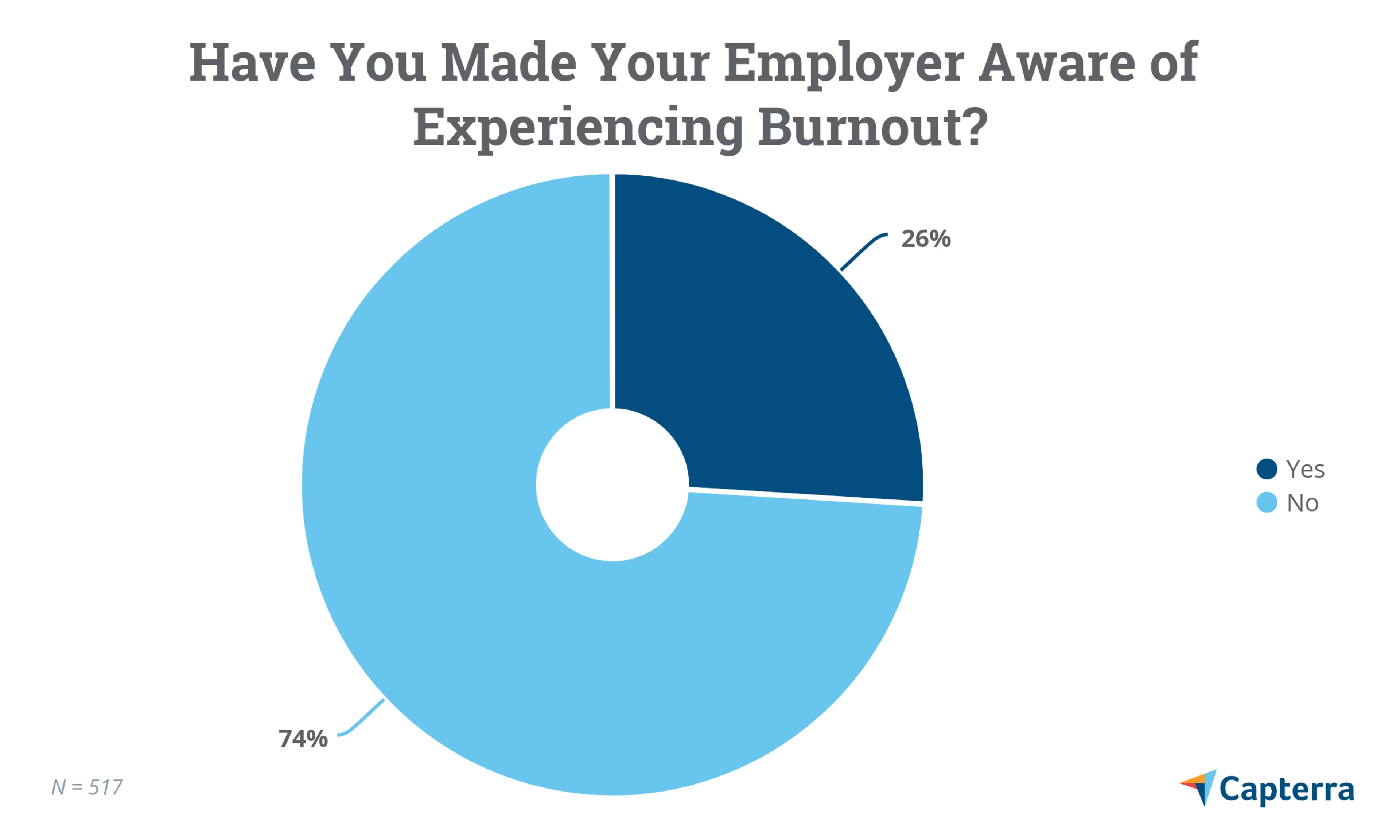With 74% of burned-out workers keeping their struggles hidden, it's on you to catch these employee burnout signs before it's too late.

One week, your star employee seems to be doing well, albeit a little less productive than usual. The next, they're using all their PTO. Before long, they're walking out the door to work elsewhere.
That's how quickly employee burnout can strike from the employer's perspective.
But from that affected employee's point of view, burnout was a slow descent that happened over months—if not years; a path paved by a myriad of pain points like unrealistic deadlines and a lack of recognition that could've been addressed if someone in power had noticed.
5 employee burnout signs to keep an eye on
That may seem unfair, to put the burden of burnout diagnosis on management or HR instead of those actually experiencing burnout. But when 74% of burned-out employees haven't told their employer about their struggles, it's clear that employers need to do more to intervene or risk watching their best and brightest make their exit.

To help you identify burnout in your own workforce before it's too late, here are five employee burnout signs that may seem inconspicuous on the surface, but could point to a bigger issue.
A refresher: What is employee burnout?
The World Health Organization (WHO) defines burnout as “a syndrome conceptualized as resulting from chronic workplace stress that has not been successfully managed."
Burnout sign #1: Drowsiness or outright exhaustion
A few yawns in an 8 a.m. meeting are to be expected, but if one of your employees repeatedly shows signs that they're not getting enough quality sleep, it could be a sign of burnout.
In a 2018 study, those suffering from professional burnout were found to have “significantly higher insomnia troubles, sleep fragmentation, and non-restorative sleep" than those not suffering from burnout. In addition, 83% of burned-out employees in our own survey report feeling “tired and drained," making it the most commonly cited symptom.

If one of your workers seems more lethargic than usual, it's rarely a bad idea to check in and see if everything's OK.
Burnout sign #2: Frequent illness
Though we tend to think of burnout as a mental condition, the stress that burnout puts on the body can manifest in a very physical way. Stress from burnout leads to a weakened immune system, which leads to illness.
A Gallup study found that employees who identify as burned out are 63% more likely to take a sick day. If your company separates vacation days from sick days instead of lumping it all together as PTO, you can use your human resource information system (HRIS) or attendance tracking system to see if someone is using more sick days than usual. Outside of flu season, that could indicate they're suffering from burnout.
Burnout sign #3: Withdrawal
As the WHO points out, burnout is characterized by “increased mental distance from one's job." Disengagement from day-to-day work is an obvious symptom here—procrastination, lower quality of output, etc.—but other forms of withdrawal can take shape too:
An employee who was once at nearly every social event starts to show up less and less.
Someone who used to always speak up in meetings is suddenly a lot quieter.
A worker who was always keen to volunteer for side projects stops raising their hand.
Another sign related to withdrawal is isolation. If you notice a worker putting themselves on an island more and more, it could mean they're suffering from burnout.
Burnout sign #4: Hostility
Once amenable to change and able to work well with others, employees suffering from burnout can quickly lose patience for anything that might present an additional stressor to their work lives. As a result, they can be more combative in meetings with other departments, or more likely to question changes to strategy or process.
Hostility can also rear its head in performance reviews, where burned-out workers can prickle at the slightest bit of constructive criticism.
All told, if you get a sense that an employee is becoming increasingly inflexible or unwilling to grow and adapt, burnout could be the cause.
Burnout sign #5: Fuzzy memory
When a person becomes stressed out, their body produces cortisol: a hormone intended to help that person navigate and react to that stress. It's the same hormone that kicks in the “flight or fight" response when you encounter a bear, for example (I'd pick “flight" in that case, but you do you).
Great in small doses, cortisol can have undesired effects if produced too often (like when you're burned out), and one such effect you should be on the lookout for is forgetfulness. A study published in Neurology found that people with higher levels of cortisol in their bloodstream have "lower brain volumes and impaired memory."
If a normally diligent employee suddenly starts dropping the ball on assigned tasks or forgetting important meetings, it could be a sign that you should intervene.
What to do if you suspect an employee is burned out
Forty-six percent of HR leaders in a Kronos survey say employee burnout is responsible for up to half of their annual workforce turnover. If you don't intervene and provide real relief, your numbers will be just as ugly.
When you suspect an employee is suffering from burnout, here are some things to do:
Talk to them! It is more than OK for a manager or HR rep to ask a worker if they're burned out. In fact, that employee has probably been waiting for someone to broach the topic. From there, you can discuss what's causing it and how to solve it.
Implement different channels for feedback. Some employees may be open to a one-on-one conversation about their struggles, while others prefer a more discreet means of airing grievances. For this latter group, employee engagement software with pulse survey functionality is great.
Create (and market) burnout solutions. If you haven't considered burnout solutions like flexible work arrangements or employee assistance programs (EAPs) before, do so. But whatever burnout solutions you implement, make sure employees don't forget about them after onboarding. Continuously marketing these solutions on the company intranet, in emails, and around the office are vital to promoting usage.